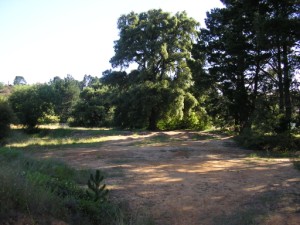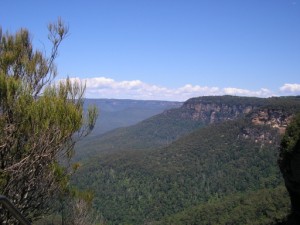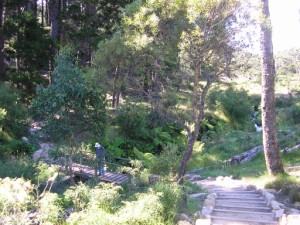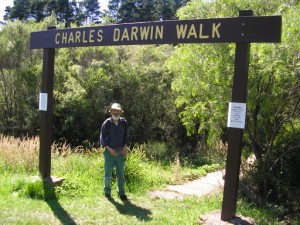The term ‘landmark tree’, coined by the English environmental organization ‘Common Ground’, describes those trees that tell us something about a place. Such trees carry stories and contribute to distinctive local character and there are a number in the Blue Mountains.

One of the most important of these, in my view, is the Evergreen Oak (Quercus ilex) located at the rear of a modern sporting oval in Wentworth Falls. It was planted at a ceremony in January 1936 by Mr. W. W. Froggatt, President of the Field Naturalists’ Club of NSW, to celebrate the centenary of Charles Darwin’s visit to Wentworth Falls (or The Weatherboard as it was then known) toward the end of his long voyage as a naturalist on HMS Beagle. Around midday on 17th January 1836, Darwin and his guide “baited their horses” at the Weatherboard Inn on their way to Bathurst. The tree also marks the site of the old inn.
I have long been fascinated by Darwin and his voyage on the Beagle and with celebrations this year marking his 200th birthday and the 150th anniversary of the publication of his On theOrigin of Species by Means of Natural Selection, I’m sure this place will attract a good number of visitors. Given his impact on the way we think about the world, Charles Darwin may well be the most significant figure to have visited the Blue Mountains.
Darwin’s tree and the Weatherboard Inn site are located only a short walk up the hill from the Wentworth Falls railway station. Built in the late 1820s, ‘The Bathurst Traveler’ soon became known simply as ‘The Weatherboard Inn’ after the locality, which in turn had taken its name from a weatherboard store depot placed here during the construction of the Western Road. A triumph of popular usage that survived until 1878, by which time the inn had long closed and the locality was given its current name of Wentworth Falls!
All that remains of the inn now is a disturbed piece of ground beside the oval. Council bulldozers accidentally uncovered some foundations in the 1980s and a hasty archaeological excavation unearthed the usual flotsam of brick, pottery, clay pipes, nails etc. before it was all covered up again. There was talk of creating an historical precinct but nothing came of it. A revival of interest, though, may well be at hand.

Darwin, like his horses, probably took refreshment after arriving at the inn on that hot January day in 1836. Then, as he records in his journal, he went for a walk “following down a little valley and its tiny rill of water” to where that ‘tiny rill’ plunged spectacularly into the vastness of the Jamison Valley. This “magnificent” scene greatly impressed him: “… one stands on the brink of a vast precipice, and below is the grand bay or gulf (for I know not what other name to give it), thickly covered with forest.”
Europeans may well have begun following the path Darwin trod to the Weatherboard Falls as early as the establishment of the aforementioned road storage depot in October 1814. With the opening of the inn in the late 1820s, word-of-mouth and the active encouragement of the early innkeepers (who probably cleared parts of the developing pathway and made it more accessible) led to the establishment of what could be the earliest ‘tourist’ walking track in the Blue Mountains.
Following years of neglect, interest in the track and its associations with Darwin were revived in the mid-1980s. I remember, as a still fairly new local studies librarian, being invited in January 1986 by the artist Renis Zusters whose property bordered the track, to celebrate the 150th anniversary of Darwin’s excursion to the falls by spending an hour or so walking in his footsteps.

Turning a bend in the track we were surprised to find Darwin himself, in the guise of the actor Tim Elliot (another Wentworth Falls resident), suddenly among us. Our companion for the remainder of the walk, Darwin was also the guest of honour when the then Mayor of the Blue Mountains, Peter Quirk, unveiled a small plaque attached to a rock face above the path. It is still there, not far from the “magnificent” view he remarked upon, and reads: “Charles Darwin passed this way in 1836, remembered by his friends in 1986.”
Twenty-five years later, in January 2006 (the 170th anniversary), my daughter Petah (born 1988) and I walked a much improved track constructed during the intervening years. New steps, raised boardwalk sections, bridges and hopping-stone creek crossings, have now replaced the rough path known to locals from the early years.
Unfortunately, Darwin recorded precious little detail of his walk. This was not the case, however, with two other naturalists, one who preceded him by two years and one who followed him down this path three years after his visit.
When the Austrian aristocrat and botanist, Baron Charles von Hugel, hired a gig and drove alone over the Blue Mountains to Bathurst in June 1834, he slept at the Weatherboard Inn, describing it as “a wretched place, despite its pretensions”. It was very cold when he woke the next morning but he rose early, assembled his botany bag and seed-papers and, with one of the inn’s stable-hands as a guide, set off for the falls before breakfast.

He found the track neglected and the going difficult.
“Just two men”, he remarked in his journal, “could make an excellent track to the waterfall in a single day but, as things are, you can hardly get through. Only by taking considerable leaps across the stream, which has cut a deep bed in some places with over-hanging banks, is it possible to reach the falls with half-dry feet.” He noted the presence of Grevillea acanthifolia and concluded that, despite the difficulties, “it is worth getting wet feet to see these falls”.
Louisa Meredith also “wet her feet in the creek”, but “with no great objection”, when she walked to the falls in the hot November of 1839 and her account resonates with the obvious joy she experienced. She found among the reeds of the creek “the great green frogs and bright dragon-flies”, discovered the delicately beautiful “fringed violet growing alone on a thin transparent stem” and came upon “a group of eight or ten splendid waratahs, straight as arrows” that she couldn’t bring herself to pick (it would have been “sacrilege”, she wrote). After the tiring heat and dust of the Western Road, these small encounters refreshed her spirits. She delighted in the small things of nature and reveled in the “moist greenness” of it all.
While much has changed since Darwin’s time, with exotic weed invasion (actively resisted by a local bush regeneration group) and the encroachment of residential properties to within sight at certain points, there is still much to interest the naturalist. The path wanders through a variety of vegetation communities, from the immediate creek-side environment to the hanging swamps with their clumps of button grass, to areas of open forest.
If you are lucky the endangered Blue Mountain skink might pop its head up between the panels of one of the boardwalks and, on a good day, a variety of birds will also put in an appearance. Honeyeaters are drawn to the nectar-rich banksias found along the walk and the thin, raspy cries of Yellow-tailed Black Cockatoos haunt the high tops of the trees.
During the breeding season (September to January) a male Satin Bowerbird might also be observed at his bower arranging his collection of blue trinkets. They “think about blue like words” wrote the Australian poet David Campbell. It can take seven years for the male bird to fully develop its adult plumage, as deeply and intensely blue as the mountain valleys themselves often are.
Along the course of the creek there are quiet pools and shady retreats to accommodate the reflective walker and the water tumbles in several places over small waterfalls and cascades that become more pronounced the closer you get to the falls. Weeping Rock is perhaps the most famous of these, an image that featured on thousands of postcards at the end of the 19th century.
“With every step you take closer to the precipice”, wrote von Hugel, “the view opens up more, until you suddenly come to the edge of the chasm, over which the stream plunges with a rush”.

Following his walk to the falls, Darwin rode on to spend the night at the Scotch Thistle inn at Blackheath. While he only lunched at the Weatherboard on his outward trip, on returning from Bathurst six days later he “slept at the Weatherboard, and before dark took another walk to the amphitheatre”.
I have now walked in Darwin’s steps on numerous occasions and in all weather, in the heat of summer (as he himself did) and on days of cold, drizzling rain. While the modern Darwin’s Walk begins through a grand entrance in Wilson Park, on the southern side of the Great Western Highway, I think it always preferable to start where Darwin himself did, at the site of The Weatherboard Inn. On a warm day the spreading branches of the Darwin Tree create a pool of shade, a good place to reflect for a moment and adjust the mind to nature and past times. A good way to begin an hour or two in the company of the great naturalist!
© John Low
notes
To read more about Charles Darwin’s, Louisa Meredith’s and Baron Charles Von Hugel’s journeys over the Blue Mountains to Bathurst:
DARWIN, Charles. “A Journey to Bathurst in January, 1836”, in George Mackaness ed. Fourteen Journeys over the Blue Mountains of New South Wales 1813-1841, Sydney: Horwitz-Grahame, 1965.
MEREDITH, Mrs. Charles. Notes and Sketches of New South Wales, During a Residence in the Colony from 1839 to 1844, Sydney: Ure Smith, 1974.
VON HUGEL, Baron Charles. New Holland Journal: November 1833-October 1834, Melbourne: MUP/Miegunyah Press, 1994. Translated & edited by Dymphna Clark.







